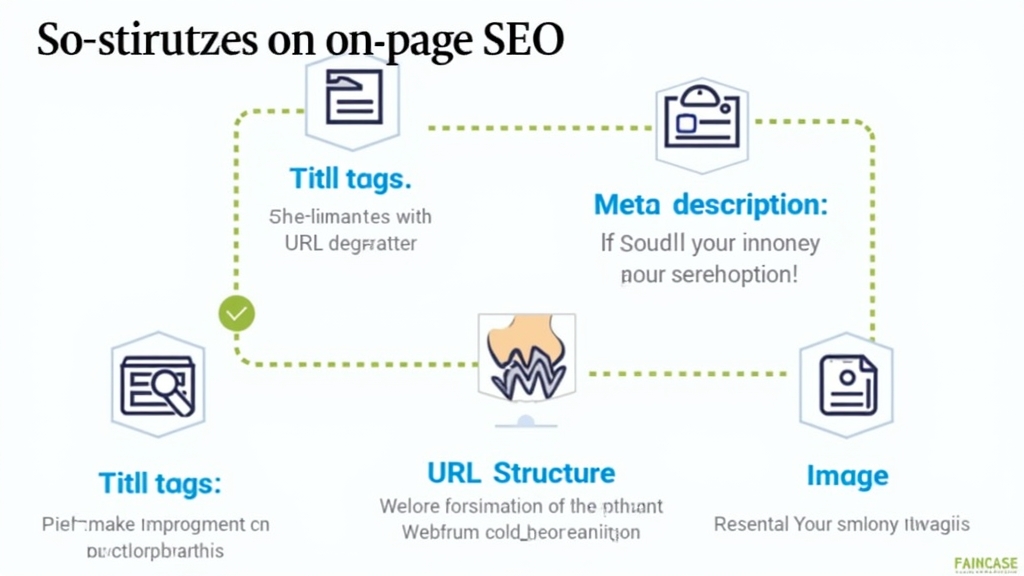Effective Marketing Strategies: On-Page SEO Techniques for Success
Introduction
Understanding On-Page SEO and Its Importance in Digital Marketing
In the fast-paced world of digital marketing, on-page SEO is crucial for your website’s visibility. It involves optimizing individual web pages to rank higher and earn more relevant traffic in search engines. By focusing on elements like content quality, title tags, and user experience, you can significantly improve your site’s performance. This article will guide you through effective on-page SEO techniques that can help you achieve success in your marketing strategies.
Key Elements of On-Page SEO
Title Tags: Crafting Click-Worthy Headlines
Title tags are one of the first things users see when they search online. A well-crafted title tag should be clear, concise, and include your primary keyword. Aim for around 60 characters to ensure it displays fully in search results. For example, instead of a generic title like “Gardening Tips,” consider something more engaging like “10 Essential Gardening Tips for Beginners.” This not only attracts clicks but also improves relevance to search queries.
Meta Descriptions: Writing Compelling Summaries
Meta descriptions serve as a brief summary of your page content beneath the title tag in search results. They should be around 150-160 characters long and include keywords naturally. A good meta description entices users to click by highlighting what makes your content valuable or unique. For instance, “Discover expert gardening tips that will help you grow a thriving garden this spring!” This approach encourages more clicks while improving your page’s click-through rate (CTR).
URL Structure: Best Practices for SEO-Friendly Links
An organized URL structure helps both users and search engines understand the content of a webpage better. Use short, descriptive URLs that include relevant keywords without unnecessary parameters or numbers. For example, instead of using “www.example.com/page123,” opt for “www.example.com/gardening-tips.” This clarity not only aids in indexing but also enhances user trust.
Content Optimization Strategies
Keyword Research: Finding the Right Terms to Target
Keyword research is essential for identifying terms that potential visitors use when searching online. Tools like Google Keyword Planner or SEMrush can help you find high-volume keywords related to your niche. Focus on long-tail keywords—phrases with three or more words—as they often have less competition and attract targeted traffic. For instance, instead of just targeting “gardening,” consider “best gardening tips for small spaces.”
Content Quality: Creating Valuable and Engaging Material
High-quality content is key to keeping visitors engaged on your site longer. Ensure that your articles are informative, well-researched, and answer common questions within your niche. Use headings and bullet points to break up text for easier reading; this keeps users interested and reduces bounce rates—an important factor in SEO rankings.
Internal Linking: Enhancing User Experience and SEO
Internal linking connects different pages within your website, guiding users through related content while boosting SEO value across those pages. When writing new articles or updating old ones, link back to relevant posts using anchor text that describes what readers will find there (e.g., “Learn more about organic gardening”). This strategy helps distribute page authority throughout your site.
Image Optimization Techniques
Alt Text: Improving Accessibility and SEO
Alt text describes images used on web pages; it’s vital for accessibility as screen readers use it to convey information about visuals to visually impaired users. Additionally, including relevant keywords in alt text can enhance image searches’ effectiveness—helping boost overall page ranking too! Instead of generic phrases like “image1,” use descriptive phrases such as “colorful flower garden layout.”
Image Compression: Balancing Quality and Load Times
Large images can slow down load times significantly—a critical factor affecting user experience (and thus rankings). Use tools like TinyPNG or JPEGmini to compress images without losing quality before uploading them onto your site; this ensures faster loading speeds while maintaining visual appeal.
User Experience Factors in On-Page SEO
Page Speed Optimization: Ensuring Fast Load Times
Fast-loading pages lead directly to better user experiences—and improved rankings! To optimize speed effectively:
- Minimize HTTP requests by reducing scripts/stylesheets.
- Enable browser caching so returning visitors don’t need everything reloaded each time.
- Utilize Content Delivery Networks (CDNs) which store copies closer geographically.
These steps contribute positively towards both engagement metrics & overall performance!
Mobile Responsiveness: Catering to a Mobile Audience
With over half of all internet traffic coming from mobile devices today—it’s essential that websites adapt accordingly! Responsive design adjusts layouts based upon device size ensuring seamless navigation regardless if accessed via desktop/laptop/tablet/smartphone etc.. Google prioritizes mobile-friendly sites during indexing processes making this an integral part of any successful strategy moving forward!
Utilizing Schema Markup for Enhanced SERP Features
Types of Schema Markup and Their Benefits
Schema markup provides additional context about webpage contents directly into search engine results pages (SERPs). By implementing structured data formats such as JSON-LD or Microdata—you’re allowing crawlers greater insight into what topics/pages cover leading potentially enhanced features appearing alongside standard listings e.g., rich snippets/knowledge graphs etc.. Popular types include:
- Article schema (for blogs/news)
- Product schema (for e-commerce)
- Local business schema (for local services)
Utilizing these increases chances visibility dramatically!
Monitoring and Measuring On-Page SEO Success
Tools and Metrics for Tracking Performance
To gauge how well implemented strategies perform over time—monitoring tools become invaluable assets! Google Analytics offers insights into visitor behavior while Search Console tracks keyword performance/ranking positions etc.. Key metrics worth observing include:
- Organic traffic growth
- Bounce rates
- Average session duration
Regularly reviewing these statistics allows adjustments ensuring continued improvement towards achieving desired outcomes!
Conclusion
The Ongoing Importance of On-Page SEO in Marketing Strategies
On-page SEO remains an essential component within effective digital marketing strategies today! As algorithms evolve continuously—staying updated with best practices ensures sustained success attracting valuable audiences consistently over time!
📢 Explore More: Continue Your Journey!
If this article helped you understand on-page optimization better, check out The Ultimate Guide to Off-Page SEO Techniques! It covers powerful insights into building backlinks effectively—helping you enhance overall website authority even further.














![NEEWER 55W 18"/45cm Ring Light Kit [New Version], 5600K Dimmable ...](https://m.media-amazon.com/images/I/414QLqvZWLL._AC_.jpg)








